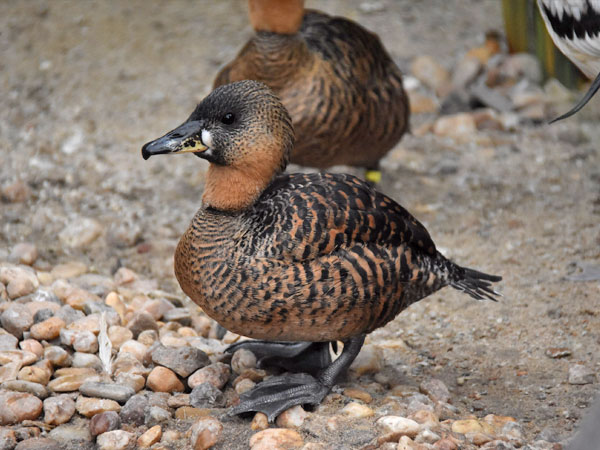White-backed Duck

Scientific Name
Thalassornis leuconotus
Measurements
| Feature | Adult |
|---|---|
| Length | 38–45 cm (15–18 in) |
| Weight | 700–900 g (1.5–2 lb) |
Status / Origin
Only species in the genus Thalassornis. Native to sub-Saharan Africa and Madagascar. Most closely related to whistling ducks (subfamily Dendrocygninae), with some traits similar to stiff-tailed ducks.
Identification
A small, dark-brown duck with a distinctive white patch on its back, often hidden when on the water. The plumage is mottled brown and buff, with a short, dark bill and dark eyes. The body is compact, and the legs are set far back, giving a diving posture. Juveniles are similar but duller.
Voice
Generally quiet. Occasionally gives soft quacks or whistles, but vocalisations are rare and subdued.
Diet
Feeds mainly on bulbs, seeds, and leaves of waterlilies and other aquatic plants. Ducklings also eat larvae of lake flies and small aquatic invertebrates.
Distribution
Found across sub-Saharan Africa from Senegal and Chad in the west to Ethiopia in the east, and south to South Africa. A separate subspecies is found only in Madagascar.
Habitat
Lakes, ponds, marshes, and swamps with dense vegetation. Prefers quiet, freshwater wetlands where it can dive and remain concealed.
Breeding
Nests among dense aquatic vegetation, often on floating platforms of reeds or hidden in marsh plants. Clutch size is typically 4–7 eggs. Both parents may assist in raising the young.
Behaviour
Highly adapted for diving and escape by submerging rather than flying. Can stay underwater for up to 30 seconds. Prefers to dive when threatened, making the white back difficult to see. Generally shy and secretive.
Wintering
Largely resident, with only local movements in response to water availability.
Conservation / Threats
Protected under the Agreement on the Conservation of African-Eurasian Migratory Waterbirds (AEWA). Mainland African population is estimated at 10,000–25,000 individuals. The Madagascar subspecies is highly vulnerable; surveys found only 37 individuals at Lake Antsamaka in 2001. Threats include hunting, wetland destruction, and invasive species.
